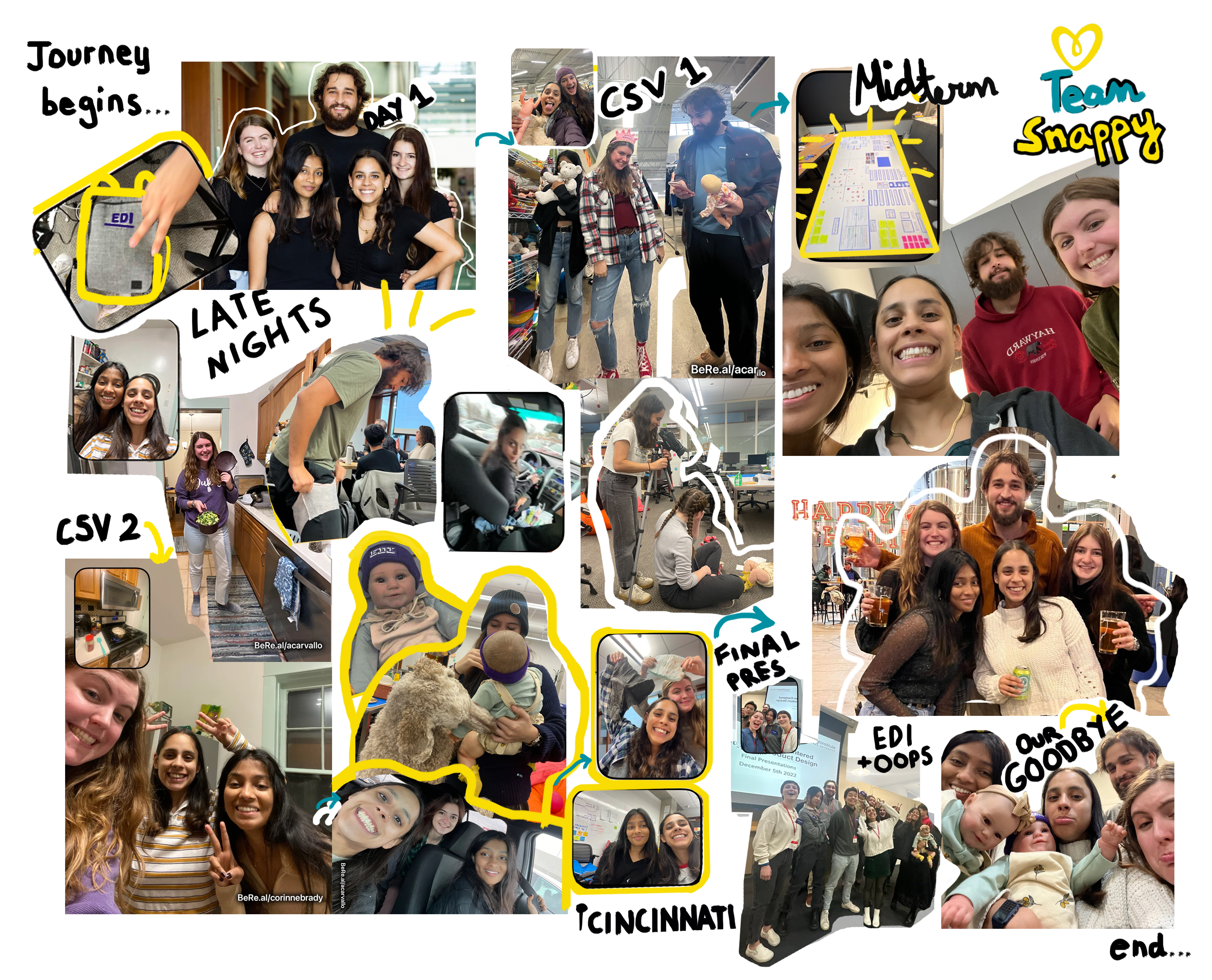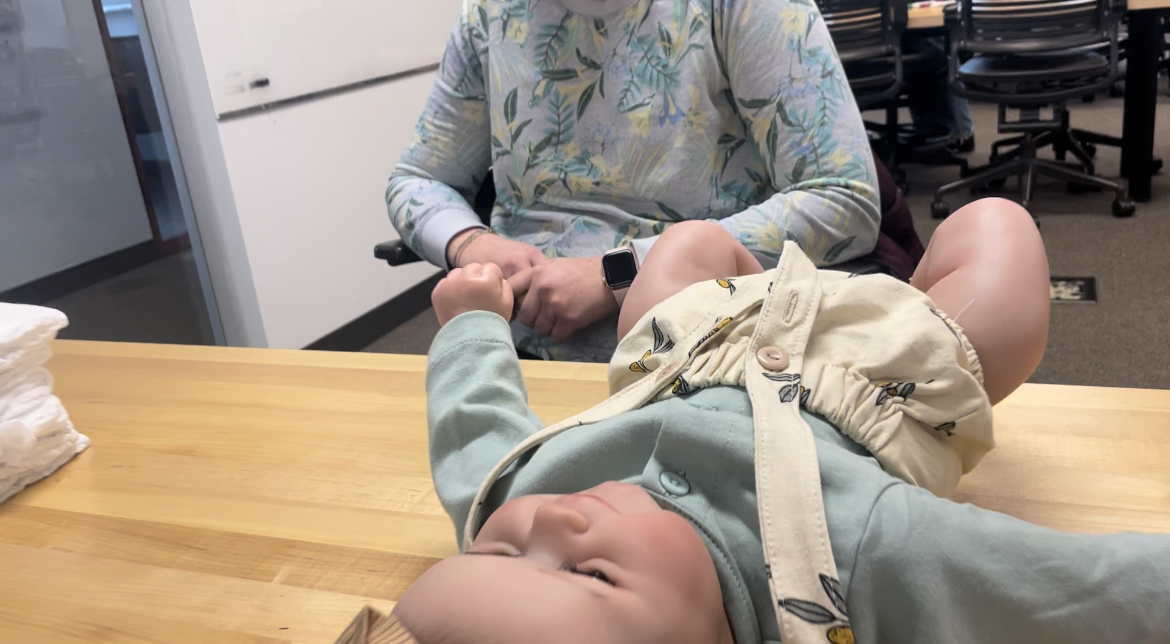Snappy
Next-gen diaper for inclusive and improved baby care experience with P&G


OUR CHALLENGE
Developed a product concept that enhances P&G's existing diaper portfolio and provide an idea to improve the diapering experience.
THE OUTCOME
Identify solutions that could simplify and speed up the diaper-changing process for everyone, including parents with varying abilities.
Problem framing
Interviews
Exercise design
Research synthesis
Design requirements
Brainstorming
Prototyping
Prototype testing
Iteration
Client pitch
MY ROLE
TIMELINE
10 Weeks
** This project remains under NDA and certain details cannot be disclosed.
Design Research: Understood user behaviors, motivations, and needs through contextual inquiry and other methods.
WHAT I DID
Product Design: Applied learnings from user research to create a usable and useful product solution.
The Context
Inclusiveness in product design is crucial for ensuring that all users, regardless of their abilities or limitations, can access and use products with ease and efficiency. And the goal was to develop a solution that enhances P&G's existing product portfolio and aligns with the company's commitment to inclusivity and accessibility.
As a team of designers and researchers, we were excited to take on the challenge of creating and improving the diapering process, which can be a difficult and time-consuming task for many parents, especially those with varying abilities.
By the end of 10 weeks, we would pitch P&G a final product concept addressing the project brief and incorporating solutions to observed consumer tensions and feedback. Our product pitch would include a prototype, pitch video, user journey map, and synthesized user research.
scroll down to jump to the solution ⬇️
3
We started with a client kickoff, meeting our partners, and receiving a project brief centered around a fundamental question.
Research
How might we improve the diapering experience to evolve the current process and solve for unmet needs?
Through our research and discussions with project sponsors, we narrowed our focus to products and a specific target user group to refine our design direction. Understanding user needs was at the core of our human-centered design approach.
1
In-home Interview
To begin our research, we conducted in-home user interviews to understand the problem space and see the diapering process, considering none of us had prior experience. We created a discussion guide that framed the conversation.
Going in-home and seeing the consumers in their environments framed a vital part of the process —observing and listening. It's one thing to hear users talk about their experiences with a product or process, but seeing them interact with it in their environment is entirely different. The small details or nuances can often be easily overlooked without in-person observations. We could identify insights and pain points by being physically present and seeing their experience first-hand.
These interviews gave us valuable insights and an understanding of consumer needs, behaviors, and pain points. I personally conducted two interviews and took notes for 2.
In our second round of user research, we used various activities, such as ranking sets and category sorting, to understand user interest in existing and novel diapering concepts. We also conducted secondary research through social listening, analyzing the competitive landscape, and collecting data on consumer behaviors and analogous products.
We recruited a few new consumers for the third round because they aligned more closely with our target demographic. Because of this, our feedback on our second round of prototypes was much more detailed and specific, allowing us to move forward confidently with our final product.
2
Prototype Testing
Prototyping
Involving users in the design process with physical low-fidelity prototypes can provide a clearer understanding of the product's intent and foster more honest feedback. Hence it was essential to use our insights and pain points to create a variety of physical prototypes to understand the needs further.
We created 11 prototypes using different existing products and materials and sewed and soldered them to form our first-round prototype. To gain insights into consumer preferences, we tested our seven prototypes with the same set of participants, allowing them to interact with the prototypes and providing us with their initial reactions. Through co-brainstorming with participants, we created a better diapering experience, observing how they interacted with the product and imagining its potential impact on their lives.
Using low-fidelity physical prototypes in user engagement can provide consumers with a clear understanding of the product's purpose and encourage candid feedback. It was imperative to create simple prototypes and think of feasability that didn’t add unnecessary extra parts.
4
Synthesis
Synthesizing our observations, tension, findings
Solution
From here, we arrived at our final design, which reflected the feedback we received from every round of interviews. We put a lot of thought into this prototype to ensure that it satisfied all of our design requirements, pitching it to the clients.
We successfully designed a product that fastened the diapering process. The main feature promoted a new method of diapering that considers the existing process (maintaining familiarity) and adds extra value to the consumer of different abilities (making it more straightforward).
Our research and findings will be added to Procter & Gamble’s project which is currently in development. After completing the course, we shared our concept and recommendations with the client.
The feedback we received on our prototypes during the site visit did not meet our expectations, which presented some challenges. While we anticipated that one or two prototypes would stand out as consumer favorites, none were well-received. Although the consumers appreciated certain aspects of a couple of the prototypes, it took us some time to determine which features we should incorporate into the final design.
To address this issue, our second round of testing was significant. We developed another round of 10 prototypes, which were much more successful than the first. We believe that combining objective and active listening and blending multiple design elements into each prototype contributed to the success of the second round.
Throughout the process, our team synthesized the findings. Our research involved using stimuli and observing product interactions to identify existing consumer habits and pain points.
The Process
1
3
2
my first time soldering but also using my sewing skills!
4
We ensured diverse representation in our interviews.
Key Learnings
Through this project, I realized that the key to creating a product that truly meets user needs lies in understanding their perceptions and practices.
My biggest takeaway was that what users express as their current practices or preferences may not always align with reality. Therefore, it's imperative to conduct design research in the user's environment to identify the root of their pain points and design requirements. Take into account the contradiction between what they say and what they do.
It’s also important to remember that we’re not always aware of what we do out of habit, so observing and questioning mundane tasks can be very revealing. It's essential to balance emotional and functional needs to create products that meet users' needs on multiple levels.
Implicit + Explicit
Conducting research in the user's environment is crucial for gaining insights into their behaviors and needs.
Looking at Extreme Users
It is important to consider a wide range of users, those who are representative of the target audience and extremes to create inclusive design.
Next Time...
Embrace the Ambiguity
Keep iterating and be willing to go back and start over. Design is an iterative process that requires constant testing and learning from feedback.
Implicit + Explicit
Conducting research in the user's environment is crucial for gaining insights into their behaviors and needs.
Copyright © 2024 Ritika Ramesh. All rights reserved.










